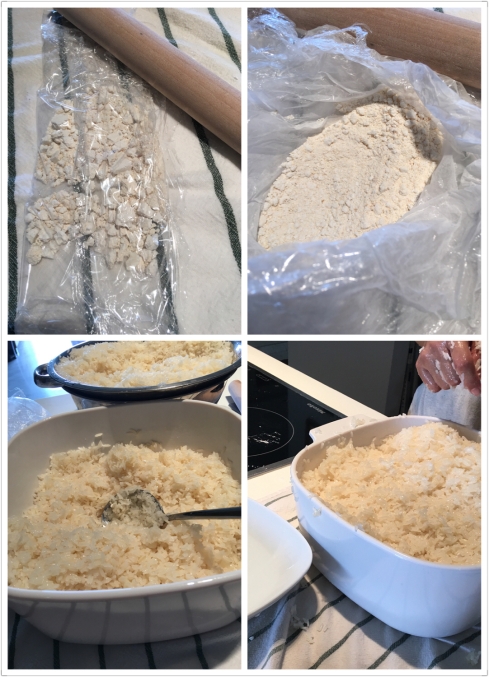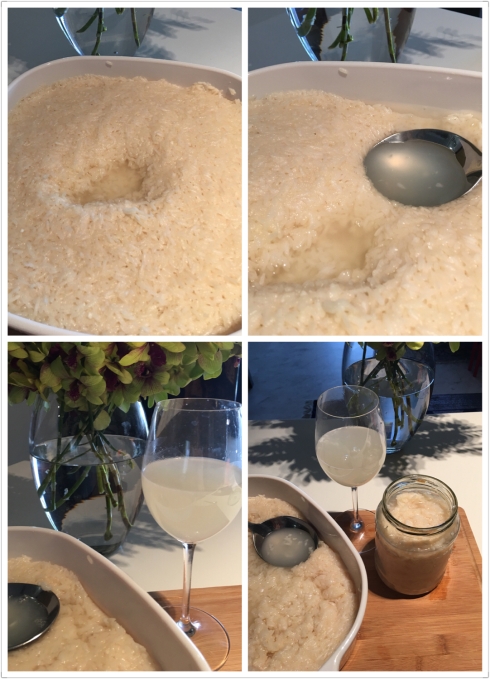Recipe from Spoonful Chinese Cooking Instructor Cai Li
This gentle, sweet-sour, marvelously aromatic homemade liquor is a common flavoring for all kinds of China regional cuisines. You can find the rice wine (sometimes called Chinese Cooking Wine) in the Asian supermarkets, but the homemade version is much more delicious and it is surprisingly easy to make. No preservative is added. It keeps for ages in the fridge.
Yields 1.5 – 2 liters of Rice Wine
Ingredients
- 1800g White Glutinous Rice白糯米
- 20-25g Wine Yeast 酒曲or酒药 (It is available in a little white ball about an inch in diameter or a biscuit and can be spotted in clear package in the Asian grocery markets. A simple recipe is sometimes written in the package.)
- Water
- 50g Vodka (optional)
 Equipment
Equipment- A big mixing bowl
- A colander 漏勺/滤锅
- Parchment paper (烘培纸) or cheesecloth or 棉纱布
- A 6-quart airtight container
- A steamer 蒸锅

Method
- Sanitation is very important. Make sure all the equipment and your hands are well cleaned and air dry. Everything that touches the rice at every stage must be absolutely clean. If there is even a whisper of oil or contamination anywhere along the way, the whole batch could go bad in an instant.
- Rinse the glutinous rice in running water till the water becomes clear. Soak the rice in the clean room-temperature water for at least 3 hours. (No need to cover.) Drain.

- Place parchment paper (or a clean wet cheesecloth) in the basket of the steamer. Add into the rice. Use chopsticks to gently stir to loosen the rice. This would help water steam go through for a fast and even cooking in the process followed.

- Cook over high heat for 25 minutes after the water starts boiling. In the middle of the process, insert chopsticks in the rice and move up and down for a couple of times. This step helps loosen the rice for the same reason mentioned in step #5. The rice shall become sticky and translucent if it is properly cooked. Move the rice to a colander. Rinse in the running water to cool it off. Be very careful as the rice is quite hot. Drain.

- Use a rolling pin to break down the wine yeast to make it almost powder. Move the rice into an airtight bowl by batches. Sprinkle the wine yeast powder on top of each batch of the cooked rice. Gently pat and press down the rice to tighten the mix in the container.

- Add a 250-gram room-temperature water in a clean bow, form a well of 7-8cm in diameter in the center of the rice, rinse your hands in the water to make sure no yeast left in your hands. Then pour all the water into the well.

- Cover the container. Seal it with cling film or plastic bag. Keeping the mix WARM for 2-3 days is also very important. You can even wrap the container with a kitchen towel or a bath towel. Place the container in a place undisturbed with the ideal room temperature of 28-30℃.
 In 24 hour later, you have the option of opening the cover and pour into 50g Vodka on top of the rice. Then cover and re-wrap the container again. The alcohol helps prolong shelve life of the final product of your rice wine. You can leave the bottled wine on the shelve of your pantry for many months. You have the option of not storing it in the fridge.
In 24 hour later, you have the option of opening the cover and pour into 50g Vodka on top of the rice. Then cover and re-wrap the container again. The alcohol helps prolong shelve life of the final product of your rice wine. You can leave the bottled wine on the shelve of your pantry for many months. You have the option of not storing it in the fridge.
- In 48 hours or so later, uncover the container. The mass of fermented rice shall float on top of the wine. Use a really clean spoon to gently press down the fermented rice. You should see wine comes out on the top of the container. Taste the wine. It should be sweet and alcoholic. Rice wine is successfully done now. Or let the mix ferment for another day until you like the balance of the flavors. Then refrigerate. It will keep for many months. But I doubt that it will be hanging around that long once you try it.

Cai Li Blakeman

Cai Li Blakeman works for Spoonful as the Chinese Cooking instructor. Cai Li was born and raised in China and has lived in Beijing, Washington DC and Singapore. She received her culinary training at the Le Cordon Bleu in Kuala Lumpur, Malaysia in 2014. She is also a food consultant and blogger. She shares easy recipes and stories on homemade Chinese and Asian food on the Facebook page #sentosadough and her blog of www.lets-playdough.com.
Prior to pursuing her passion for cooking and culinary education, she was a PR and Communications professional and had held management positions in global firms including United Technologies Corporation (UTC), NEC, Edelman, Johnson Controls and Kimberly-Clark.
